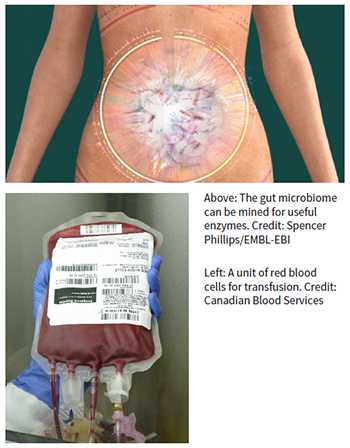Scientists have discovered a pair of gut microbial enzymes that worked in tandem to convert blood cells of the type A to those of type O by removing the surface molecule alpha-1,3-linked-N-acetylgalactosamine (GalNAc) from the surface of red blood cells.
If the findings pan out for clinical use, they could help increase the supply of type O red blood cells available for transfusion.
There is an overall shortage of donated blood, which the approach will not fix. But "O blood is coveted blood because it can be universally donated," Stephen Withers told BioWorld.
 Because of its universal donation capacity, it is also regularly in even shorter supply than other blood types. In the U.S., the Red Cross most recently sounded the alarm in mid-May that it was down to a two-day supply of type O blood for emergency rooms.
Because of its universal donation capacity, it is also regularly in even shorter supply than other blood types. In the U.S., the Red Cross most recently sounded the alarm in mid-May that it was down to a two-day supply of type O blood for emergency rooms.
Blood types are determined by the presence or absence of two separate sugars, on the surface of red blood cells. Individuals with GalNAc on their red blood cells have type A blood, while those with galactose (Gal) are type B, and those with both types of sugars are type AB. (Blood can also be Rh-positive or Rh-negative, which is determined by a surface protein. The enzymes discovered by Withers and his colleagues do not affect Rh type.)
GalNAc and Gal are far from the only sugars on cells. "Every cell in our body is coated in very specific sugars," Withers said, and those sugars are "a little bit like the baggage label on a cell – they identify something about the cell, and how it interacts with its environment."
Withers is a professor of chemistry and biochemistry at the University of British Columbia, and the senior author of the findings, which were reported in the June 10, 2019, issue of Nature Medicine.
Such sugars are also antigens, and while people are immune tolerant to the antigens of their own blood type, they will have a violent, potentially fatal reaction to red blood cells with the wrong antigen. In that sense, GalNAc and Gal are more like labels advertising their carrier's fealty to FC Barcelona or Real Madrid, respectively. If you have one label, showing up in the opposing team's stronghold is a bad idea.
Type O red blood cells have neither GalNAc nor Gal on their surface, and so can be used to transfuse everyone, regardless of blood type. (The situation is the opposite with plasma, the fraction of the blood that contains no cells but serves as a conduit for nutrients and antibodies. Because individuals with blood type AB make antibodies to neither GalNAc nor Gal, they are universal plasma donors.)
In a perfect world, there would be no increased need for type O blood. Both donors and recipients would roughly mirror the general population, which consists of about 45% type 0, 40% A and 10% B, with the remainder of the population being type AB.
However, in dire emergencies, there may not be time to identify an individuals' blood type – or that individuals' blood type may be in especially short supply at that moment.
Mining the microbiome
In principle, the idea of removing the antigens from red blood cells to convert them into type O blood is "not a new concept," Withers noted.
But enzymes capable of doing so that had been previously identified were either not efficient enough or not specific enough to make them viable candidates for large-scale use.
Withers and his team found such enzymes by mining the gut microbiome.
Withers described his lab's original discussions about where to look for a bacterium that degrades blood.
"Grave-robbing," he said with deadpan humor, "wasn't seriously considered," which left very few species such as mosquitoes and leeches that feed on human blood.
However, "in parallel, we were quite well aware that mucins" – heavily glycosylated proteins that are the principal component of the mucus that lines the gut, as well as the airways and the female reproductive organs – are composed of a number of sugars," including the same sugars that determine blood type.
Gut bacteria, he said, are "opportunistic little devils," and it seemed likely that someone in the more than 1,000 known species of gut bacteria had figured out how to clip the sugars from mucins, and use them as a food source.
Metagenomic screening confirmed that hunch. The commensal species Flavonifractor plautii produced two enzymes, FpCBM32 and FpGH36, that worked together to turn red blood cells from A to O in a two-step procedure.
The team will continue to look for better enzymes, Withers said, but "the principle focus is on... extremely important but much less exciting part of massive safety testing."
For now, he said, "we don't know for sure that our enzyme isn't chopping something else off of a red blood cell as well." His team is working with Canadian Blood services "to make sure converted blood is completely safe."
Even if the approach is found to be safe enough for broad use, Withers does not envision type A blood routinely being converted; there would be an albeit small additional cost to doing so, and it's "probably always easier to give the right type of blood."
But recombinantly produced enzymes could be used to alleviate acute shortages of type O blood.
"The big advantage here would be in inventory control," he said. "That's where blood services see the need."
